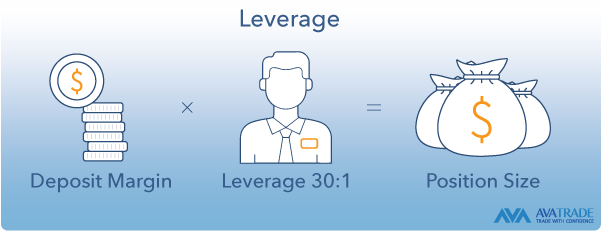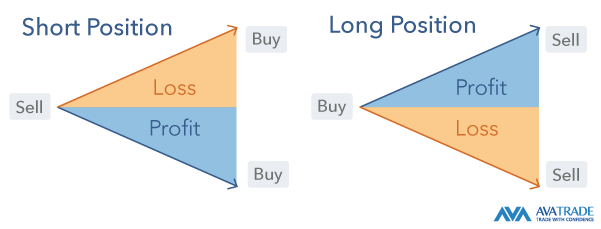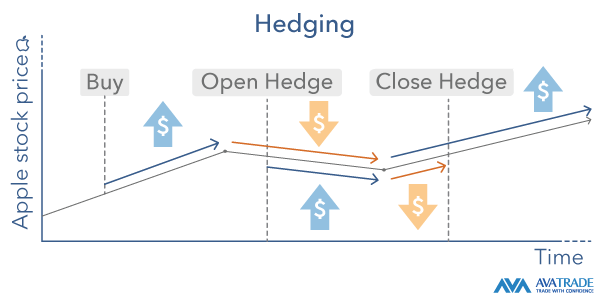What Is CFD Trading and How Does it Work?
A Contract for Difference (CFD) is a financial instrument that allows traders to speculate on the price movements of various assets without owning the underlying asset.
When you trade CFDs, you enter into an agreement with AvaTrade, the broker, to exchange the difference in the price of the underlying asset from the time you open the trade to the time you close it.
One of the key characteristics of CFDs is their flexibility. Unlike traditional investments, CFD contracts typically do not have an expiration date, allowing you to hold positions for as long as you desire. Moreover, in certain countries, CFDs are often exempt from stamp duty, reducing the overall transaction costs.
Another advantage of CFDs is the ability to go long or short on an asset. This means you can potentially profit from both upward and downward price movements, depending on your market expectations.
CFDs also provide access to a wide range of markets, including stocks, indices, commodities, Forex, and cryptocurrencies, offering ample opportunities for diversification.
As we progress in this guide, we will explore the intricacies of CFD trading, including leverage, advantages, risks, practical examples, and risk management strategies.
By the end, you will have a comprehensive understanding of CFD trading and the tools needed to navigate this dynamic market.
How Does CFD Trading Work?
What Instruments Can be Traded as CFDs?
CFDs offer a wide range of tradeable instruments, allowing you to access various financial markets. With AvaTrade, you can trade CFDs on popular assets such as stocks, indices, commodities, currencies (Forex), ETFs, and cryptocurrencies. This diverse selection enables you to explore different markets and capitalise on various opportunities.
Going Long Versus Going Short
One of the key advantages of CFDs is the ability to go long or short on an asset. Going long means buying a CFD with the expectation that its price will rise, enabling you to profit from an upward price movement.
Conversely, going short involves selling a CFD with the anticipation that its price will decline, enabling you to profit from a downward price movement.
This flexibility allows you to profit in both rising and falling markets potentially.
CFD Margin and Leverage
CFD trading often involves the use of leverage & Margin.
- Leverage – allows you to control a larger position with a smaller initial capital outlay. This is done by borrowing funds from your broker. With leverage of 10:1, traders can control a position worth $10,000 using only $1,000 of their own funds.
- Margin – Margin is basically the amount of money a trader uses to control a leveraged position. The deposit margin (initial margin) is the initial capital needed to open a position ($1,000 in the previous example), while the maintenance margin is the minimum account balance to sustain the position. If the account balance falls below the maintenance margin, a margin call is issued, requiring the investor to add funds or face the sale of their securities.
AvaTrade provides leverage options of up to 33:1 that amplify your exposure to the market. However, it’s essential to manage leverage carefully, as it can magnify both potential profits and losses.

CFD Trading Costs
When trading CFDs, you should be aware of the fee structure associated with your trades. The two primary fees are the spread and overnight fees.
- The spread refers to the difference between the buy and sell prices of a CFD and serves as compensation to the broker.
- Overnight fees, also known as swap fees or rollover fees, may apply when holding CFD positions overnight. These fees are associated with the cost of maintaining leveraged positions beyond the market’s close and can be influenced by factors such as interest rates and market conditions.
Determining Profit and Loss in CFD Trading
Profits and losses in CFD trading are determined by the difference between the opening and closing prices of your positions. If the market moves in your favour, you can generate a profit. Conversely, if the market moves against your position, you may incur a loss. It’s important to note that losses can exceed your initial investment, highlighting the significance of risk management strategies.

Hedging With CFDs
CFDs offer the opportunity for hedging strategies to manage risk or offset potential losses. There are two aspects to consider:
- Hedging physical market exposure with CFDs: If you already have a physical position in an asset, you can use CFDs to hedge that position. By taking an opposing CFD position, you can potentially offset any adverse price movements in the physical market. For example, you have invested your savings in Apple stocks. The upcoming company news is expected to have a negative impact on the share price. You could hedge the expected losses to your investment portfolio by opening a short CFD position on Apple stock. A short position generates profits if the underlying asset’s price is decreasing. This short CFD position would neutralise the losses in the physical portfolio. To learn more, check out our article on Short Selling.
- Hedging one CFD position with another: You can also hedge one CFD position with another related CFD. For example, if you have a long position on a particular stock CFD, you can hedge that position by taking a short position on another stock CFD within the same sector.

CFD Trading Timeframes
CFDs do not have an expiration date like options or futures contracts. You can hold CFD positions as long as you desire. However, it’s important to note that if you hold CFD positions overnight, you may incur overnight fees. Different traders may prefer different contract durations based on their trading styles and objectives.
Advantages of Trading CFDs
Trading Contracts for Difference (CFDs) offer several advantages that make them a popular choice among traders. Let’s explore these advantages:
- Leverage: CFDs provide the opportunity to trade with leverage, allowing you to control a larger position with a smaller initial investment. This means that you can potentially amplify your profits if the market moves in your favour. However, it’s important to note that leverage also increases the risk of losses, so proper risk management is crucial.
- Access to Various Markets: CFDs offer a wide range of tradeable instruments, including stocks, indices, commodities, currencies, and cryptocurrencies. This allows you to diversify your trading portfolio and take advantage of opportunities in different markets.
- Long and Short Positions: With CFDs, you can profit from both rising and falling markets. Going long allows you to benefit from an upward price movement while going short enables you to profit from a downward price movement. This flexibility allows you to take advantage of different market conditions.
- No Ownership of the Underlying Asset: When trading CFDs, you do not own the underlying asset. This eliminates the need for physical ownership, such as storing or delivering the asset. It also simplifies the trading process, as you can enter and exit positions quickly without the logistical complexities associated with owning the actual asset.
- Cost-Efficient Trading: CFD trading generally involves lower transaction costs compared to traditional investment methods. This is because you do not incur expenses such as stamp duty or brokerage fees associated with owning the underlying asset. Additionally, CFDs often have tighter spreads compared to other financial instruments.
- Liquidity: CFDs are traded on liquid markets, which means that you can usually enter and exit positions easily. This ensures that you can take advantage of price movements and have more control over your trading activities.
- Hedging Opportunities: CFDs provide opportunities for hedging strategies. You can hedge your existing positions in the physical market or offset potential losses by taking opposing CFD positions. This allows you to manage risk effectively and protect your portfolio against adverse market conditions.
- Access to Advanced Trading Tools: Many CFD brokers offer advanced trading platforms equipped with various tools and features. These platforms provide real-time market data, technical analysis indicators, and risk management tools, allowing you to make informed trading decisions.
It’s important to remember that while CFDs offer several advantages, they also involve risks. Understanding these risks and implementing effective risk management strategies are essential for successful CFD trading.
Learn More with Us! You’ve started your journey in CFD trading. Now, let’s go deeper. Our How to Trade CFDs guide is packed with easy-to-follow strategies, CFD trade examples, tips, and step-by-step instructions to help you get ahead.
Why Trade CFDs with AvaTrade
- Security and Regulation: Our operations, licensed and regulated by multiple international authorities, embody our commitment to providing a secure, fair, and transparent trading environment. Choose AvaTrade, where your security is our priority.
- Comprehensive Financial Education and Insights: Gain access to a wealth of educational resources, including webinars, articles, video tutorials, and e-books, designed to empower you with the knowledge and skills to navigate the financial markets successfully. Our in-depth articles and insights cover various aspects of CFD trading, helping you make informed decisions.
- Risk-Free Demo Account: Practice trading CFDs with our risk-free demo account, available to our clients free of charge. Experience real market conditions and test your trading strategies without risking your capital. It’s the perfect opportunity to build confidence and refine your skills.
- Seamless Transition to Real-Money Trading: When you’re ready to trade with real money, AvaTrade offers robust trading platforms equipped with advanced tools and features. Trade a wide range of instruments with competitive spreads and reliable execution. Benefit from our unique trading resources, including access to Trading Central for comprehensive market analysis and AvaProtect for protecting your trades against potential losses.
Start Your CFD Trading Journey with AvaTrade
Take the first step in your CFD trading journey with AvaTrade. We provide the tools, resources, and support you need to succeed. Open a risk-free demo account today and practice your trading strategies.
When you’re confident and ready, open a real-money trading account on our powerful platforms. Benefit from our comprehensive financial education, unique trading resources, and dedicated customer support.
Open a Demo account to practice what you’ve learned or a Real account to start trading today!
































